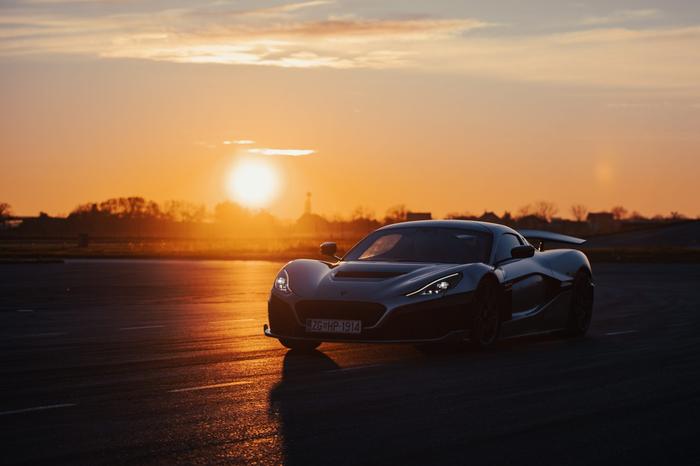2022 Rimac Nevera Coupe Review

We test the crazy-fast Rimac Nevera
If someone asks you if you’d like to drive the world’s fastest electric car, there’s only one answer.
Review
Pros: technology, speed, exclusivity, stability
Cons: price, practicality, indicator buttons
The call came on an otherwise grey afternoon in Dublin: “Would you like to come to Croatia to try out the Rimac Nevera?” I had my airport parking booked before the conversation was over.
You see, the Nevera had only days before been crowned as the fastest electric vehicle in the world, topping 412km/h, which should be no surprise given its 1,914hp maximum power output. That is not a typo. Given that there will only ever be 150 examples of the Nevera made, and each one will cost in the region of two million Euros, you can understand why we were keen to take Rimac up on its offer of a chance to sample it for ourselves.
Rimac Nevera Design
If you’re familiar with the Nevera’s headline figures, your first view of the car might be a little underwhelming – it’s not the showiest hypercar ever created. That’s especially the case if the doors are closed and the active rear wing is in its lowest position. It looks almost Lotus-like, with hints of the BMW i8 around the rear lights.
Pop open the butterfly doors and it begins to look more special, though there’s no arguing with the exceptionally low and wide proportions. Other details to watch out for including the three LED slots either side. Buyers can specify colours for these, and they also change colour depending on the selected driving mode. A nod to the Croatian origin of the cravat can also be found in the sculpting of the car’s sides.
Rimac Nevera Interior
Inside, the Nevera seats two snugly in gorgeous bucket seats. Every switch and surface is of high quality and made by Rimac in its own production facility. That adds to the bespoke nature of the car and goes some way to justifying the high price. It’s also well-equipped, and buyers can choose from a range of colours and finishes.
A central touchscreen is complemented by another digital display in front of the passenger and crystal-clear digital instrumentation for the driver. There’s a high degree of configurability in all of this – and the seats and steering wheel are adjusted via the touchscreen.
On the subject of adjustment, the myriad driving sub-systems are altered via the protruding circular stalks in the middle of the dashboard. They work brilliantly and remove the need for the driver to glance at a screen when on the move.
Shame that the simple flat-bottomed steering wheel houses controls for the indicators and wipers, etc, though Rimac isn’t alone in this approach.
Rimac Nevera Performance & Drive
With such lofty performance figures, you’d assume that driving the Nevera is dominated by its insatiable desire for higher speeds, but it, thankfully, turns out to be a far more nuanced experience. That’s down to the clever development of a suite of different driving modes, which alter a wide range of the car’s sub-systems.
For example, the Range mode is optimised for eking out distance between charge ups. There’s a 120kWh battery pack and an official range of 490km and the ability to recharge it on a 500kW DC charger – not that any of those exist anywhere nearby.
Twist the mode selector into Cruise and the car is set up for long-distance driving on the motorway. Though the suspension is always on the firm side, it isn’t particularly uncomfortable at speed, meaning longer journeys are a breeze. It’s relatively quiet as well, though the motors make a lot of noise if you put your foot down.
There are four powerful electric motors at work – one for each wheel – and they make forward progress completely effortless on the road. You merely think about the speed you want to achieve, and the car seems to magically get there in the blink of an eye. The motors aren’t quiet when working hard either, giving the Nevera a unique sound, but no less thrilling than that of a powerful petrol engine.
We get a chance to push the car a lot harder on a test track, exploring the Sport, Track and even the Drift mode. With firmer damping, a lower ride height and the active aerodynamics at work, it is quite an experience. Rimac employs its own torque vectoring algorithm, too, using the four motors to help any driver extract maximum performance from the car at any given moment.
That it’s ridiculously quick should be of no surprise, but what perhaps is is how stable and forgiving a chassis it has. On track, its brakes and steering are sublime, too, allowing keen drivers to really gel with the car and thoroughly enjoy their time at the wheel. It’s one of the most engaging electric cars in the world, not just the fastest.
Rimac Nevera Pricing
As mentioned at the top of the article, the Nevera would cost in the region of €2 million to register here. There are some build slots in the 150-only production run available still if you fancy one, though you will have to make do with left-hand drive.
Carzone Verdict: 5/5
It might be possible to find a couple of things that we don’t love about the Nevera, but in reality, this car represents a seismic change in the landscape of supercars and hypercars, where unfathomable performance is somehow mixed with real agility and driver engagement. To say it’s special is an understatement.



